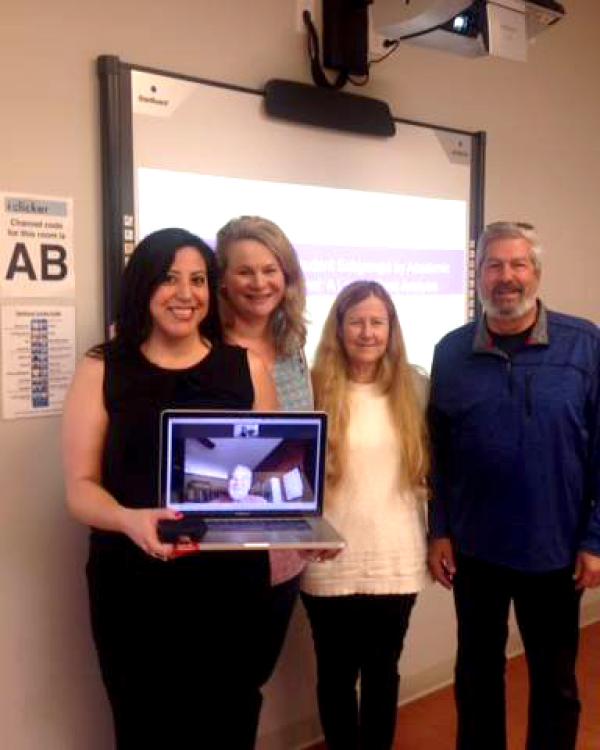
Veronica Fematt (l.) with her dissertation committee: Dr. Karen Nylund-Gibson, Dr. Betsy Brenner, Dr. Mike Gerber, and (via Skype) Dr. Daniel Solorzano from UCLA.
Alumna Veronica Fematt (Ph.D., Education, ’17) was recently hired as the assistant director of UCSB’s McNair Scholars Program, a welcome return to campus. The goals of McNair are to increase the number of first- generation, low-income and/or underrepresented students in doctoral programs, and ultimately, to diversify the faculty in colleges and universities across the country. It’s a well-matched job for Fematt’s passions and research interests, as you shall see in this interview with her.
GGSE: What are some insights from your most recent job at Cal State University Long Beach, where you worked as the Policy and Practice Dissemination Coordinator for the Center for Evaluation and Educational Effectiveness?
Fematt: My position at CSU Long Beach showed me the importance of working collaboratively both within and across institutions. Learning from others and sharing best practices resulted in real improvements in student support initiatives and/or programmatic interventions. Another crucial insight is the importance of disseminating your work to a broader/national audience in digestible and easily accessible formats (e.g., briefs, webinars, infographics). Overall, I learned a lot of new skills at CSU Long Beach and worked with great educators across the CSU and community college system that loved their work and really cared about the success of underrepresented students in higher education.
GGSE: We heard from your advisor, now professor emeritus Michael Gerber, that you organized GGSE's first higher education research group. Can you tell us more about this group?
Fematt: Yes, as a graduate student I co-founded the GGSE Higher Education Research Group (HERG) with my advisor Dr. Gerber. HERG was composed of several graduate students who shared intersecting research interests pertaining to community colleges and the transfer pathway. We met on a weekly basis, collaborated on research projects, and presented our work at several academic conferences.
I also initiated the Higher Education Action and Research Consortium (HEARC), which formed out of a need for interdisciplinary consultation on issues pertaining to students of color. HEARC invited renowned faculty and professionals in the community to share their research and/or expertise. For instance, we organized events on topics such as the Chicana/o education pipeline, the criminalization of Black and Latino males, and student activism in higher education. We also provided workshops and special topic seminars for graduate students. Through our efforts, HEARC committee members fostered a community focused on higher education both in GGSE and at UCSB.
GGSE: What motivates you to do the work you do?
Fematt: Growing up, I experienced inequitable schooling conditions that almost pushed me out of school. I ended up at a continuation high school where students were treated as statistics. Fortunately, this experience became the impetus that inspired me to pursue a postsecondary education. I was determined to change the schooling conditions and outcomes of Black, Indigenous, people of color (BIPOC). After graduating high school, I enrolled at a local community college and began my journey towards reaching my academic and professional goals. Today, my work continues to be motivated by my goal to improve the conditions BIPOC students encounter throughout the education pipeline. I want to see more students, like me, make it to-and-through college.
GGSE: Do you have any advice for current GGSE students?
Fematt: My advice for GGSE students would be to find your people. I was fortunate to come in with a great cohort that became my extended family. I met some of my best friends through my cohort. My advice for graduate students of color who might be struggling with sense of belonging at GGSE/UCSB would be to seek out counterspaces. For those not familiar with Dr. Yosso’s concept of a counterspace, a counterspace is a “safe” space for marginalized/nondominant groups. Typically, a counterspace is comprised of people who share the same/similar racial/ethnic/cultural background as you. At Predominantly White Institutions (PWIs), it might be difficult to find a counterspace – especially at the graduate level. In those situations, you have to look outside of your institution.
As a graduate student, I sought out Dr. Solórzano at a conference because I wanted to learn more about Critical Race Theory and admired his work and research. He invited me to attend his monthly seminars at UCLA, which became my counterspace. All of his graduate students were working on research projects that aligned with my interests around race, racism, and white supremacy. Every time I left his seminars, I felt invigorated, re-inspired, and motivated to continue my work.